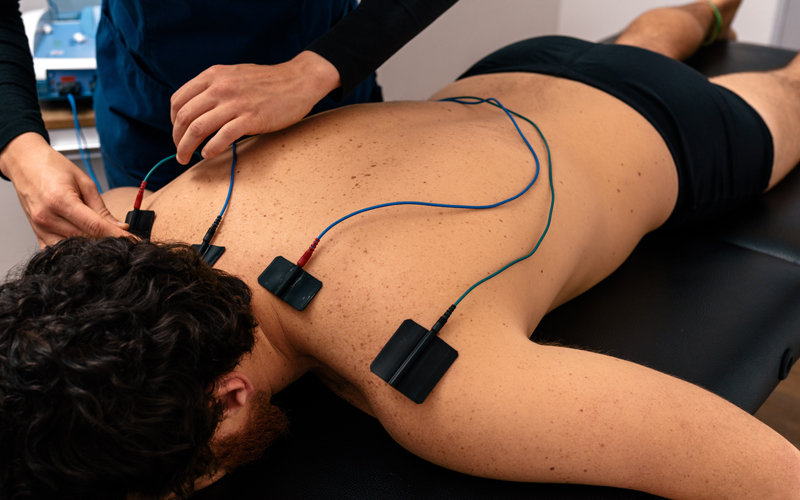
admin
May 21, 2024
Important Advantages Of Electrotherapy For Physiotherapy Interventions
Physiotherapists treat musculoskeletal disorders, manage pain, and restore range of motion using a number of instruments. In addition to techniques like targeted exercises, stretching, and joint mobilization, electrotherapy may be suggested by your Physiotherapist in Sushant Lok 1 at Physio 4 Life as a course of treatment.
Trained physiotherapists can use electrotherapy to treat injuries, accelerate healing, and provide pain relief by using sophisticated devices that give tailored doses of electrical stimulation to your body’s muscles, tendons, or nerves.
What is and how electrotherapy works?
Many physiotherapists employ electrotherapy, a potent treatment that uses targeted and regulated electrical stimulation to treat musculoskeletal injuries, nerve discomfort, muscle atrophy, and chronic pain.
Electrotherapy is a mild, non-invasive technique that acts by stimulating muscles and nerves via the skin’s surface. Depending on the gadget your practitioner employs, electrotherapy is believed to function in a number of ways.
- Send out electrical impulses that lessen pain by blocking or interfering with the body’s pain signals.
- aid in the release of endorphins, which are chemical messengers that the body uses to naturally reduce pain.
- To lessen atrophy, contract the muscle tissue.
- Induce a thermal effect in the body to enhance circulation and promote healing.
- Induce pain-inhibiting, collagen-producing, and inflammatory-reducing cells.
Six Advantages of Electrotherapy for Physiotherapy Procedures
The optimum electrotherapy technique for you and your needs can be determined with the assistance of your physiotherapist at the best Physiotherapy clinic in Gurgaon, Physio 4 Life. Several significant advantages of electrotherapy can be obtained, contingent upon your musculoskeletal or medical condition:
- Diminish discomfort in the nerves
Nerve pain can include numbness, tingling, burning, weakening in the muscles, and generalized discomfort across the body. Nerve pain is caused by electrical impulses that are sent by your body’s nerves, which carry pain signals, albeit the exact origin of the pain varies. A TENS machine can be used by a physiotherapist to target and lessen nerve pain by “confusing” or interfering with the pain signals that your body sends out.
- Encourage musculoskeletal injury recovery
It has been demonstrated that several electrotherapy methods, particularly shockwave therapy, are useful in treating a range of musculoskeletal disorders. Shockwave therapy not only helps lessen pain, but it can also speed up the healing process by boosting blood flow to an injured area. For injuries such as these, shockwave therapy may be beneficial.
Elbow from tennis
- Plantar fasciitis
- The condition known as carpal tunnel syndrome
- Jumpers’ knee
- Injury and pain in the shoulders
- Physiotherapists use electrotherapy to treat common sports injuries like sprains and strains because it can assist enhance circulation and promote healing in a region.
- Use a drugless, non-invasive method of pain management
An effective, non-toxic, and non-addictive treatment for chronic pain is electrotherapy. Whether you have persistent back or neck discomfort, you are aware of how these ailments can lower your quality of life and make it difficult to carry out everyday tasks.
While taking painkillers may be necessary in certain situations, electrotherapy provides a potent substitute that doesn’t come with the side effects of drug addiction. Furthermore, electrotherapy provides a non-invasive approach to managing persistent pain and fostering tissue regeneration. In certain situations, electrotherapy can avoid the need for invasive procedures like surgery.
- Stop the atrophy of muscles
Muscle atrophy—the degeneration of a muscle—can occur when an injury, disease, or nerve damage prevents muscles from being exercised. Muscle atrophy can cause discomfort and stiffness in addition to limiting movement and lowering quality of life. Fortunately, electrical muscle stimulation (EMS), a type of electrotherapy, can help ward against atrophy by encouraging muscular contraction. A TENS unit is sometimes used to help lessen the pain associated with atrophy, while EMS is sometimes used to stimulate muscles to contract.
- Promote circulation to aid in healing of wounds
A healthy circulatory system is crucial to the healing process. Our cells receive nutrition from oxygenated blood, which also aids in accelerating tissue repair. Furthermore, a healthy circulatory system aids in the body’s detoxification. According to studies, electrotherapy devices can greatly improve blood flow in the body, which in turn improves the body’s capacity for wound healing and repair.
- Have very little to no adverse effects
Most patients who receive electrotherapy treatments report feeling better and experiencing fewer adverse effects. Actually, the adhesives used to attach the electrode pad to the skin are frequently the cause of the most frequent side effect associated with electrotherapy, which is the occasional rash or allergic reaction at the site. While there may be some little discomfort during treatment, electrotherapy is usually a painless procedure with no long-term negative effects.
- Categories
- Physiotherapy Treatment (32)
- Physiotherapy (9)
- Physiotherapy Treatment (32)